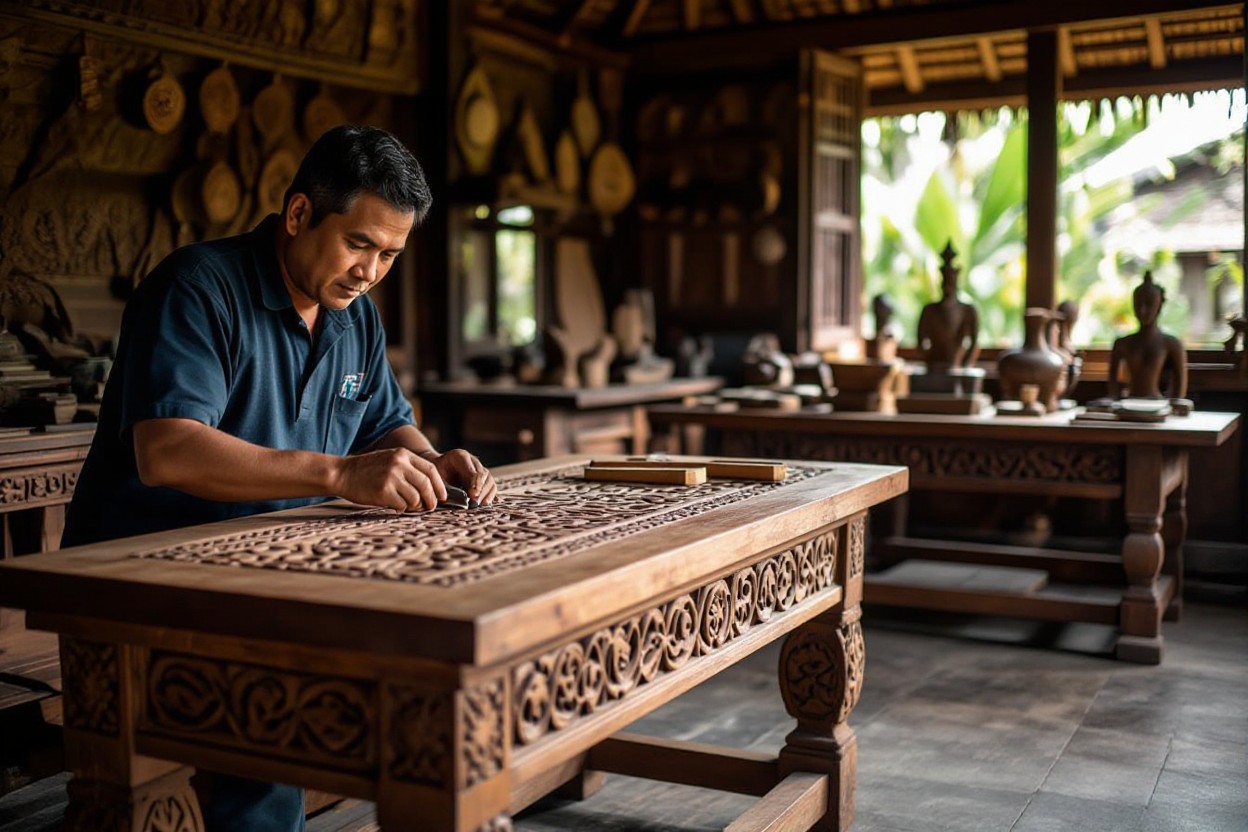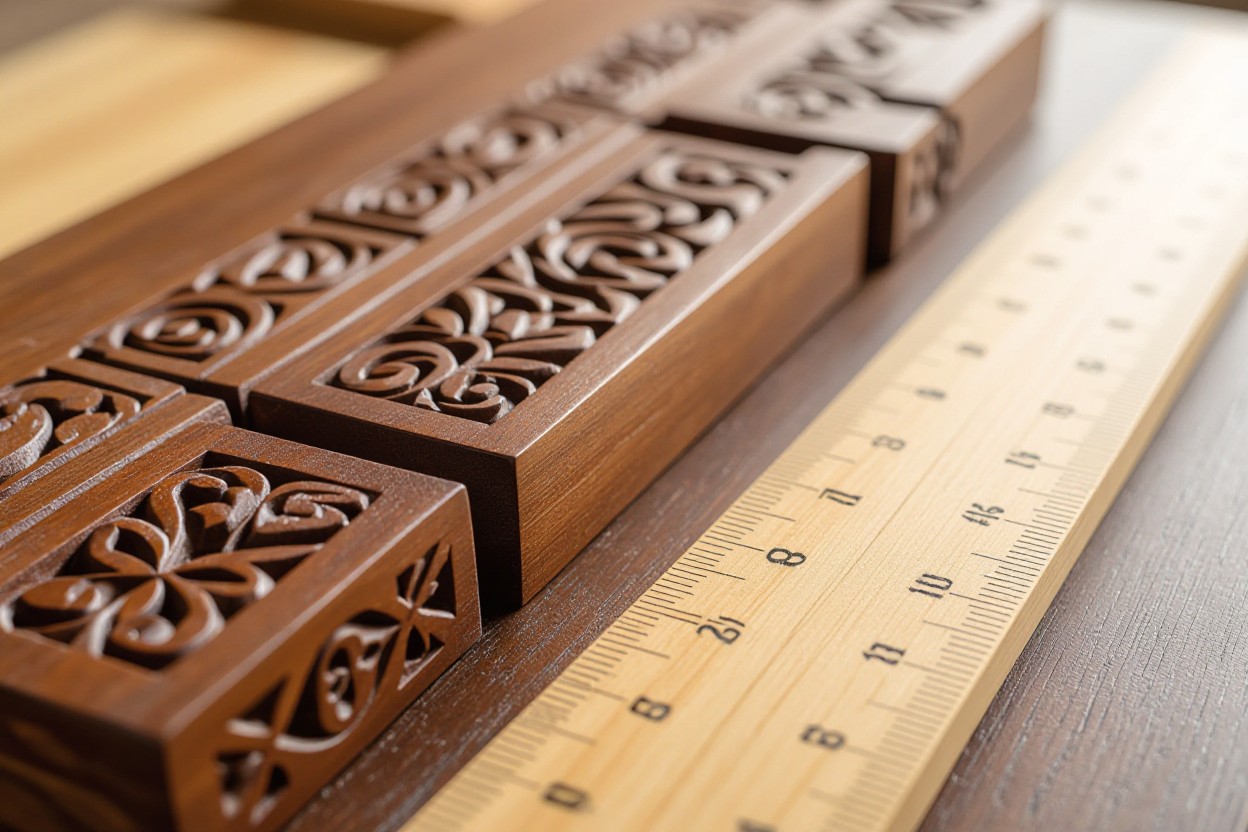Identify authentic Bali furniture by examining materials, carving details, joinery, finishes, provenance and patina; this six-step guide shows you how to distinguish genuine handcrafted pieces from mass-produced lookalikes so you can evaluate your purchase’s craftsmanship, age and value with authority and buy confidently.
The Craftsmanship of Authentic Bali Furniture
Master artisans in Bali blend centuries-old carving traditions with precise joinery, producing pieces that last generations. You can spot authentic work by crisp hand-carved motifs from Mas village, tight mortise-and-tenon joints, and finishes that age naturally. Expect production times ranging from a few days for simple pieces to several weeks for elaborately carved furniture.
Handcrafted Techniques That Stand Out
Hand carving with gouges and chisels creates the depth and shadow lines you should look for; complex panels often take 2–6 weeks to finish. You’ll also find traditional mortise-and-tenon joinery, steam-bent frames, hand-planed surfaces, and burnished finishes using linen oil or damar resin rather than uniform CNC patterns or tacky spray coatings.
The Role of Local Materials and Resources
Local woods like teak (Tectona grandis), suar (Samanea saman) and rattan define the look and longevity of Bali furniture: teak’s natural oils deter rot, suar’s dramatic grain makes standout tabletops, and rattan offers flexible, durable weaving. You should check for seasoned timber (typically 6–12 months), reclaimed timbers, or SVLK/FSC certification to confirm legal and sustainable sourcing.
Grain, density, and peel quality directly influence price and performance: suar slabs with wide, swirling grain often command 20–40% higher prices than uniform boards, while dense teak holds fine carving detail and requires less filler. You’ll also see rattan graded by diameter and peel smoothness—grade A peels indicate better outdoor durability when properly treated.
Recognizing Quality Wood Types
Assess wood by tactile and visual cues: teak (dense, oily, golden), suar/rain tree (swirling, high chatoyance), mahogany (stable, reddish tones) and jackfruit (dense, fine grain) behave differently under tools and wear; measure weight and test finish absorption—heavier boards with tight pores generally indicate higher density and durability. Look for solid end-grain, consistent color through carved areas, and any kiln-dry stamps or supplier documentation to confirm stability and provenance.
| Teak (Tectona grandis) | Natural oils, high rot resistance, density ~600–750 kg/m³; ideal for outdoor and heirloom pieces |
| Suar / Rain Tree (Samanea saman) | Bold grain with dramatic figure, used for live-edge tables and carved panels; medium-high hardness |
| Mahogany (Swietenia spp.) | Warm reddish-brown, excellent stability for carving and joinery, commonly used in fine indoor furniture |
| Mango (Mangifera indica) | Sustainable option, medium density, attractive mottled grain often used for budget-conscious polished pieces |
| Jackfruit (Artocarpus heterophyllus) | Dense, fine-grained, holds carving detail well and darkens with age; common in Balinese carved items |
- Inspect end grain: tight, small pores indicate harder species and better longevity.
- Smell freshly cut wood if possible—teak gives a faint leathery scent; resins indicate certain hardwoods.
- Tap for density: a solid, ringing sound usually means a dense, durable board.
- This should guide your purchase decisions when matching species to intended use and expected wear.
Identifying Iconic Bali Wood Species
You can spot Bali favorites by their signatures: teak shows weathered golden-brown patina and oily feel, suar flashes high-contrast waves and live edges, mahogany offers stable reddish tones prized for carving, while jackfruit provides a tight grain that accepts fine detail; check for local supplier marks or kiln-dry certificates to distinguish reclaimed or plantation stock from high-quality Indonesian hardwoods.
The Significance of Grain Patterns and Finish
Grain dictates both aesthetics and performance: quarter-sawn pieces warp less and reveal straight, uniform grain, while flatsawn boards show broader cathedrals and figure; finishes that soak into pores rather than merely sit on the surface suggest solid wood rather than veneer, and surface chatoyance in suar indicates genuine figured timber rather than printed patterns.
Examine grain continuity across joints and carved sections to verify solid construction: mismatched grain or repeating patterns can indicate thin veneer glued over cheaper cores. Run your hand along carved edges and inside recesses—solid wood will show consistent grain direction and color depth, while stained plywood often reveals cross-laminated layers at cut edges. High-quality lacquer or oil finishing that follows grain movement rather than masking it confirms authentic timber and proper surface preparation.

Distinguishing Traditional Designs from Imitations
Cultural Symbolism in Design Elements
Look for motifs tied to Balinese Hindu narratives: Kala faces over door lintels, Barong and Rangda figures, naga serpents, lotus and wayang silhouettes inspired by Ramayana and Mahabharata scenes. You can often link a piece to a region—Klungkung carvings show dense scrollwork, Gianyar favors open fretwork—and authentic items embed symbolic placement, like protective Kala at corners or narrative panels along a temple door.
How to Spot Modern Replicas
Scan for machine-made uniformity: perfectly repeating patterns, symmetrical carvings and consistent tool marks from CNC routers. Surfaces with a glossy polyurethane finish, visible screw heads, or very light weight compared with solid teak are red flags; similar large carved panels priced under $300 often signal mass-produced replicas rather than hand-carved Bali originals.
Check joinery and hidden areas for evidence: authentic pieces use mortise-and-tenon, wooden pegs and uneven chisel marks, while replicas rely on dowels, staples or visible metal screws and smooth router scars. Inspect drawer bottoms and undersides for fresh saw cuts, filler or veneer over MDF; tap tests reveal a lighter, hollow sound in veneers versus the dense thud of solid suar or teak. Patina should be uneven—uniform distress suggests artificial aging.

Evaluating the Details: Joinery and Construction
You should inspect joints closely: authentic Balinese pieces typically use hand-cut mortise-and-tenon, pegged joints, dovetails in drawers, and wooden dowels rather than visible screws or staples. Look for tight seams with minimal glue lines, tool marks from chisels, and consistent grain alignment across faces. Test stability by pressing corners and pulling drawers—wobble, squeaks, or loose pegs often indicate poor reconstruction or cheap replacements rather than original craftsmanship.
The Importance of Traditional Joinery Techniques
You’ll notice longevity in furniture using pegged mortise-and-tenon and interlocking joints because they accommodate tropical humidity and seasonal wood movement without splitting. Examples from 50–100 year-old Balinese cabinets show pegged joints holding under heavy loads, while pieces with metal fasteners often corrode or loosen. Hand-cut dovetails in drawer corners signal authentic construction and superior load distribution compared with glued or stapled alternatives.
Common Red Flags in Poor Construction
You should watch for thin veneers over particleboard, visible glue seams, metal staples/brackets at structural joints, mismatched grain patterns, and gaps wider than ~3 mm along seams. Drawers that rattle, legs attached with screws into soft core, or decorative appliqués hiding joint failures are frequent signs of low-quality assembly or deceptive refinishing aimed at masking inferior cores.
Check undersides and inside drawers for evidence: MDF or particleboard cores often show uniform, porous edges and square-cut fastener holes, whereas solid teak displays continuous grain and end-grain complexity. Remove a drawer to inspect runners—wood-on-wood runners and dovetail joints indicate authenticity; noisy nylon or metal slides, excessive filler putty, or obvious modern glue blobs point to repairs or cheap manufacturing.
Final Words
From above you can confidently spot authentic Bali furniture by checking materials, craftsmanship, provenance, finishes, artisan marks and sustainable sourcing; use your observation and questions to verify age and origin, insist on clear documentation, and trust your knowledge to choose pieces that reflect genuine Balinese design and lasting quality.


